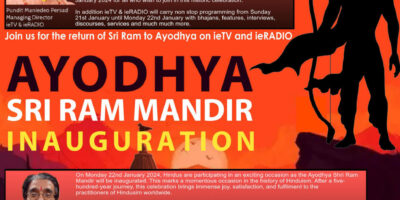 Following our recent, successful publication on Hindu death ceremonies, SWAHA Publications is embarking once again on a new book that seeks to explain Hindu wedding ceremonies. The Hindu wedding ceremony is elaborate and deeply significant. This publication will seek to explain the philosophy and reasoning that underpin its symbolic practices. It is anticipated that this book will clear up any misconceptions on Hindu wedding practices and smooth the way for any adaptations.
Following our recent, successful publication on Hindu death ceremonies, SWAHA Publications is embarking once again on a new book that seeks to explain Hindu wedding ceremonies. The Hindu wedding ceremony is elaborate and deeply significant. This publication will seek to explain the philosophy and reasoning that underpin its symbolic practices. It is anticipated that this book will clear up any misconceptions on Hindu wedding practices and smooth the way for any adaptations.
The question and answer format, which was well received in the previous publication, will be used once again. Please find listed below some of the questions that will be addressed. If there are other questions that you would like answered, please forward them to us as soon as possible so that the Paramacharyaji can address them. The closing date for submission of your questions is July 26, 2016.
We look forward to your swift response.
Questions
Before Marriage
- Why is it considered necessary for the pundit to match the birth dates of the intended bride and groom?
- What can be done if the compatibility rating is low?
- How long before should a wedding date be booked with the pundit?
- Why is coloured rice placed in invitation cards?
- How should the intended bride and groom prepare themselves during the weeks preceding the wedding?
- Is an engagement ceremony necessary and what is the procedure?
- How long before the wedding date should the engagement be done?
- What are the main pre-marriage ceremonies?
- What is hardi used in the chumay ritual?
- Is the hardi ceremony performed for anintended bride or groom who has been previously married?
- What is the significance of the dirt used in the hardi ceremony?
- Should guests partake of food before or during the hardi ceremony?
- Why does the bride wear yellow for the hardi and red during the wedding ceremony?
- What is the significance of the kangan?
- Why are nine kangan tied around some objects as well as the intended groom and bride’s hands during the hardi ceremony?
- What is the significance of the matikor ceremony?
- From where should the dirt be collected in a matikor ceremony?
- Why are only ladies allowed at the matikor and laawa ceremonies?
- Can the wedding ceremony be done without the matikor and laawa?
- What is the importance of the mehendi and mehfil functions that are held before the wedding ceremony?
Wedding Ceremony
- What are the different kinds of Hindu weddings performed?
- Can the Hindu wedding ceremony be performed on one day instead of the three-day period?
- What is the significance of imli gothaway?
- What is the significance of the kanyadaan and who gives away the bride if parents are indisposed or have died?
- Why is the stone-stepping ceremony done?
- What is the significance of the saptapadi ritual?
- Why are the heads of the bride and groom covered during the sindoor application?
- Can sindoor be worn by a woman who is marrying for the second time?
- What does the mangalsutra symbolise?
- What is the significance of paaw pujay ceremony?
- What is the role of the sai-bala(young boy at wedding)?
- How soon after the wedding ceremony can the bride and groom break their fast?
- Can one pundit perform the entire wedding ceremony?
- Why are so many relatives, including the extended families of both the bride and groom, involved at different stages of the marriage ceremonies?
- How soon can a wedding be done after a relative of the intended bride or groom has died?
- Why are interdicted foods and alcoholic beverages forbidden at Hindu weddings?
- Which of the Hindu wedding ceremonies should not be done in circumstances where the bride or groom has been previously married?
- What can be done in order to facilitate the marriage of a Hindu to non-Hindu?
- What kind of ceremony should be done where a widow/widower is to re-marry?
- Do married girls perform aarti for their parents after marriage?
- Why does the mother of the groom not attend the wedding ceremony of her son?
- What adjustments should be made to the wedding ceremony if a girl becomes pregnant before?
- What is a ‘hareesh’ and what is its significance?
General
- Does Hinduism subscribe to same-sex marriage?
- What should be done in cases where either or both parties who are getting married are under 18 years of age?
- How is the ancient practice of ‘sati’ carried out today?
- What is Hinduism’s view of having more than one consort?
Post-wedding
- What is the significance of the ‘second’ Sunday’?
- What is the significance of the reception and is it compulsory?



Nan Persad
After the wedding ceremony, when do you dispose of the stuff around the bedi and the kangan cloth and where?
Is there a ceremony for disposal and its significance?
Mulchan Ramdath
Since child marriage is a really hot topic in our country can this be addressed from a scriptural, psychological, mental, societal, physical and all other points of views, so as to put and end to all the debates that has been going on to defend this practice.
Jaidath Maharaj
If two persons of the same sex wishes to live in the Grihast Ashram, how can the Hindu Marriage ceremony accommodate such a instance especially given the reality of the phenomenon and the fact that the western world is accepting such diversity.
Jaidath Maharaj
What is the Hindu view in inter racial and inter religious marriages.
Jaidath Maharaj
Many times the couple wants to walk around the fire as they see this as the pinnacle of the ceremony but they don’t do the lawa. Can you please provide guidance on this?
Nesha
What is the meaning behind the younger sister carrying the tray on her head on the maticoor night and the morning of the wedding?
Can the younger sister still carry the tray if she is unclean due to her cycle?
What is the significance behind the 5 married women who make circular motions around the younger sister with the tray placed on her head when they return from what is termed “going for lawa”?
What is the significance of the younger sister then pouring water I think it’s in the kalsa before the commencement of puja on the maticoor night?
Can only young girls apply harder to the bride/groom on the maticoor night?
Nesha
With respect to my second question I meant what is the significance behind the 5 married women making circular motions with the lota filled with water (the motion referred to is the same as when one performs aartee except a lota of water is used) around the younger sister when she returns to the home of the bride/groom with the tray placed on her head, from what is termed “going for lawa”
Trishana
To add to the list of questions: Why is a beverage given to the bride and groom before departing to the groom’s home? Why is rice thrown when the beide and groom are leaving? What is the significance of ‘kitchrie’ in the ceremony?
asha
1. Why after the marriage ceremony does the dulahin return to her parents abode on the Wednesday, or some time after following the wedding?
2. What is the significance of chumaying? Can anyone do it? What about others who are not Hindu?